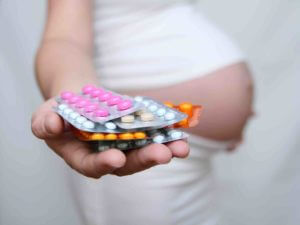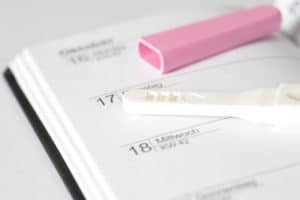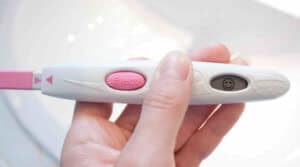How do you recognize fertile days from the cervical mucus? Is the method reliable for safe fertilization or contraception? Can the cervical mucus be influenced? Increased temperature and clear mucus, are these sure signs of ovulation?
Everything you need to know about cervical mucus, you will learn in this article.
Table of contents
What Is Cervical Mucus And How Is It Produced?
Cervical mucus also called cervical mucus, is a secretion from the cervix uteri. More precisely, from the cervical canal. This is the inner part of the cervix. It runs between the uterus (inner cervix) and the vagina (outer cervix).
The glands for cervical mucus are located in the cylinder epithelium. This is practically the skin layer in the cervical canal. This tissue consists of a layer of high cylindrical epithelial cells.
The cervical mucus is a glassy body fluid. It is produced and secreted by the glands (glandulae cervicales uteri) between the cylindrical skin cells of the cervix. Female sex hormones control the secretion of mucus. More about female hormones ((female hormones link).
The secretion is slightly alkaline. Depending on the phase of the female cycle, between 0.1 and 0.5 milliliters are secreted daily. Most of the cervical mucus is water, up to 90 percent.
The rest is shared by mucins (structuring components), proteins, enzymes, simple sugars and electrolytes. The proportions of these substances are also hormonally controlled. They are responsible for the varying consistency of the mucus.
What Are The Functions Of Cervical Mucus?
Of course, all this happens for good reasons. A look at the cervical mucus tasks:
- During ovulation, the consistency of the mucus makes it easier for sperm to ascend to the uterus.
- On infertile days, the mucus’s viscous nature creates a blockage for sperm.
- The cervical mucus balances the acidic environment of the vagina. In this way, it ensures a longer survival time for the sperm.
- The cervical mucus even provides the sperm with energy.
- It helps to ensure that only the fittest sperm reach their destination.
- A basic function of cervical mucus is to prevent germs from advancing further.
This Is How Cervical Mucus Changes During The Menstrual Cycle
The mucus in the cervix changes in the same way that is appropriate for successful reproduction. The female hormones are the clocks for this. First and foremost, these are the hormones estrogen and progesterone.
You can determinefertile days quite precisely if you develop a feeling for these changes. You can roughly observe three phases in your cycle.
After Menstruation
In this phase, hardly any mucus is secreted. The vagina feels dry. If the mucus is secreted, it is sticky or creamy. As the mucus progresses, it slowly becomes noticeable by a moist feeling in the vagina. The consistency is thick, sometimes lumpy, and sticky. It looks yellowish or whitish.
Cervical Mucus Before Ovulation(Ovulation)
With the onset of fertile days, cervical mucus becomes more transparent and thin. This change is caused by an increased release of estrogen. The vagina feels moist.
The mucus looks almost like raw egg white. It is said that the mucus is spinnable: it pulls a thread between two fingers. Now is the most favorable opportunity for sperm to reach the egg. Fertile days begin now.
Cervical Mucus After Ovulation
Now the mucus slowly becomes opaque again. It is tough, can no longer be drawn, and is sticky or lumpy. The color goes towards whitish and yellowish. It may also happen that the mucus is now completely absent.
Observing Cervical Mucus And Calculating Fertile Days
If you observe and document your cervical mucus, you can calculate fertile days. This method has become known as the Billings method. A neurologist from Australia, John Billings, first documented this method for natural family planning (NFP).
He recognized a connection between the nature of mucus and fertility.
Monitor Cervical Mucus, How Does It Work?
Check the consistency of your mucus a few times a day. In the evening, make a note of your overall impression. For this purpose, it is important to notice different criteria, because you can feel the mucus:
- Feel.
- See.
- Feel.
It is important to develop a sense for this. Therefore, try to note all three perceptions daily. Here are some examples so that you can better empathize to calculate fertile days:
- How does your vagina feel? Dry, a little moist or slippery?
- What does the mucus look like? Yellowish, whitish, clear?
- How does the mucus feel (texture)? Creamy, clumpy, liquid, spinnable?
You can determine this by going to the toilet. You can use toilet paper or your fingers to check. If you rarely notice mucus in the vagina, run your finger into the cervix. You will be able to pick up some mucus from the wall there to judge the quality.
The different cervical mucus categories can be easily and quickly documented with previously established abbreviations. You can take your own abbreviations or use the official ones:
- Ø (crossed out O): dry, no mucus, no moisture in the vagina.
- T – dry, sometimes uncomfortable feeling in the vagina, no mucus visible.
- F – vagina feels moist, but no mucus visible.
- S – mucus is noticeably thick, white to yellowish, lumpy to viscous (cannot be drawn).
- S+ – vagina feels very moist, slippery; mucus is spinnable, stringy, liquid, clear.
- S+H – this is the day when the mucus has reached the best quality for fertile days. Of course, you can determine this day only when the quality of mucus has already deteriorated again. This was then your cervical mucus peak, so to speak, the time of ovulation.
The quality of the mucus also changes within a day. Therefore, it is best to always note the overall impression in the evening according to the criteria mentioned. Before you can reliably follow it, you need some practice in perception.
Calculating Fertile Days With Cervical Mucus
If you document and evaluate the cervical mucus daily, you can use it to calculate fertile days. The probability of successful fertilization during sexual intercourse on these days is high.
This method is not suitable as a reasonably safe way to prevent pregnancy. It is better to take the temperature in addition. Together this is called the symptothermal method, a combination of the Billings method and the temperature measurement method.
If you keep a consistent record and keep fertile days free of sexual intercourse, this method has a Pearl Index of 0.4 to 1.8. For comparison: the pill has a Pearl Index of 0.1 to 0.9.
If you have noted the consistency of the mucus for one cycle, you will get a first overview of infertile and fertile days. Try to find out the S+H day retrospectively.
This is the day with the best quality of mucus, or even more precisely, the last day that you documented with the best quality s+. At the same time, it is also the day on which you recorded three days of worse quality slime.
Around this day (+/- one day) is your ovulation (fertile days). Around three days after this day, the infertile days begin. When exactly the fertile phase begins again after menstruation cannot be determined so precisely with this method. For contraception, it is therefore essential to include the increased temperature.
Calculating Fertile Days For The Desire To Have Children
After jumping out of the follicle, the egg is still viable for up to 24 hours. Fertilization must take place during this time. After that, the infertile period begins until menstruation, also called the second infertile phase.
For the infertile time before ovulation (first infertile phase) you still have to include the survival time of the sperm. These are four to five days that you can calculate as fertile days.
For family planning, the symptothermal method gives you a reliable overview of the days on which fertilization is most likely to take place.
Elevated Temperature
With the so-called basal body temperature method you get an additional certainty to calculate fertile days. To do this, you measure your body temperature every morning. Shortly before ovulation occurs, the temperature drops by at least 0.2 degrees Celsius. After that, you can detect an increased temperature by at least 0.5 degrees.
Middle Pain
The so-called mittelschmerz, on the other hand, is not a sure sign to calculate ovulation. This pain is felt by some women in the middle of their cycle. However, studies have shown that this time even deviates from the day of ovulation in most cases. The exact cause of this is still unknown.
Irregularities In Cervical Mucus
When you are aroused, there is also an increased discharge, the arousal mucus. It is similar in consistency to the clear and stringy mucus during ovulation.
However, this has no informative value for calculating fertile days. Unlike cervical mucus, excitatory mucus is water soluble. Discharge due to disease should be distinguished from cervical mucus.
A bacterial infection is often accompanied by increased discharge. In most cases, this is associated with an unpleasant odor and with discomfort in the vagina and during urination.
Hormone preparations also disturb the natural consistency of the cervical mucus, as this is hormonally controlled. The Billings method therefore only makes sense if you are not taking the pill or other hormone preparations.
After stopping the pill, wait until a normal cycle has returned. If fertilization has occurred, there may be a change in the mucus. More mucus is then often formed.
The secretion is milky and relatively liquid. However, this should not be seen as a sure sign of pregnancy.
Can You Influence The Cervical Mucus?
You can influence the quality of the cervical mucus to a small extent: By drinking enough fluids and paying attention to your diet. Many nutrients are needed for the production of hormones.
Your diet should consist mainly of nutrient-rich, varied plant foods. B vitamins are especially important for the production of hormones. In any case, consume less meat and animal products (especially from factory farming).
This is because traces of hormonal treatments can often still be found in these products. These foreign hormones can have a negative effect on your hormonal system. Improve your cervical mucus quality by.
- Drinking a lot, especially in the first half of the cycle (water, unsweetened herbal teas).
- Eating plenty of alkaline fruits and vegetables rich in B vitamins (legumes, leafy greens, cabbage).
- Less meat, dairy products, coffee and alcohol.
You cannot prolong fertile days with this. But you will improve the quality of mucus and ensure that sperm will progress faster and survive longer.
Limitations Of The Cervical Mucus Method
Even if the various mucus changes seem to be easy to determine, not every woman will have such clear results. For one thing, the mucus with its changes is very individual.
For example, some women can hardly detect any differences in their mucus quality because they basically produce so little or too much of it. At least as different are also the abilities to perceive the changes accordingly and to document them regularly.
Observing Cervical Mucus For Fertile Days To Calculate Ovulation
With a little practice, this method is very good for calculating fertile days. You get to know yourself better. After a few documented cycles you will know your individual characteristics and especially your fertile days.
In order to use this method with a reasonable degree of certainty, you should also use the temperature method. If you need some support, you can use an app to make it easier for you to manage both methods.












